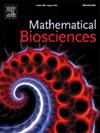Model formulation and oscillatory patterns in immune-pathogen dynamics during Brucellosis infection
IF 1.8
4区 数学
Q2 BIOLOGY
引用次数: 0
Abstract
Brucellosis, a global zoonosis imposing major health and economic burdens, is clinically marked by recurrent undulant fever linked to Brucella’s persistence within macrophages. To decipher the immune-pathogen dynamics underlying this fever periodicity, this study develops a novel mathematical model that integrates macrophage self-renewal, logistic growth constrained by cellular carrying capacity, and intracellular Brucella replication. Stability and bifurcation analyses reveal two crucial thresholds: one for infection persistence, requiring , and another for the emergence of undulant fever, triggered by a supercritical Hopf bifurcation. This bifurcation occurs when the macrophage self-renewal rate () surpasses its mortality rate () and the infection rate () lies in a critical range, marking a transition from stable equilibrium to stable limit cycles. These periodic oscillations, stemming from a dynamic imbalance between immune regeneration and bacterial proliferation, provide a direct mechanistic explanation for recurrent febrile episodes. Counterintuitively, excessive macrophage renewal or carrying capacity can destabilize the system, exacerbating febrile cycles. Our findings posit that interventions simultaneously preventing immune resource exhaustion and curbing intracellular bacterial survival could suppress these pathological oscillations, thereby proposing novel perspectives for managing chronic brucellosis.
布鲁氏菌感染期间免疫-病原体动力学的模型制定和振荡模式。
布鲁氏菌病是一种全球性的人畜共患病,对健康和经济造成重大负担,其临床特征是与布鲁氏菌在巨噬细胞内持续存在有关的反复波状热。为了解释这种发烧周期性背后的免疫-病原体动力学,本研究建立了一个新的数学模型,该模型集成了巨噬细胞自我更新、受细胞携带能力约束的逻辑生长和细胞内布鲁氏菌复制。稳定性和分岔分析揭示了两个关键阈值:一个是感染持续性阈值,需要R0 bbb1,另一个是出现波状热阈值,由超临界Hopf分岔触发。当巨噬细胞自我更新率(r)超过其死亡率(d),侵染率(θ)处于临界范围时,巨噬细胞从稳定平衡向稳定极限环过渡。这些周期性振荡源于免疫再生和细菌增殖之间的动态不平衡,为反复发热发作提供了直接的机制解释。与直觉相反,过度的巨噬细胞更新或承载能力会破坏系统的稳定,加剧发热周期。我们的研究结果表明,同时防止免疫资源耗尽和抑制细胞内细菌存活的干预措施可以抑制这些病理振荡,从而为治疗慢性布鲁氏菌病提出了新的视角。
本文章由计算机程序翻译,如有差异,请以英文原文为准。
求助全文
约1分钟内获得全文
求助全文
来源期刊

Mathematical Biosciences
生物-生物学
CiteScore
7.50
自引率
2.30%
发文量
67
审稿时长
18 days
期刊介绍:
Mathematical Biosciences publishes work providing new concepts or new understanding of biological systems using mathematical models, or methodological articles likely to find application to multiple biological systems. Papers are expected to present a major research finding of broad significance for the biological sciences, or mathematical biology. Mathematical Biosciences welcomes original research articles, letters, reviews and perspectives.
 求助内容:
求助内容: 应助结果提醒方式:
应助结果提醒方式:


